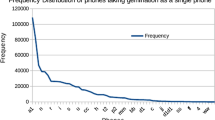Abstract
In this paper a method for the automatic generation of pronunciation lexicons including multiple word pronunciation is presented. This method is based on the application of a set of rules for grapheme-tophone conversion for Mexican Spanish. The generation of multiple word pronunciations is based on the introduction of pronunciation variants by applying allophonic rules. The performance of a speech recognition system using a pronunciation lexicon with and without multiple word pronunciations is also presented.
Access this chapter
Tax calculation will be finalised at checkout
Purchases are for personal use only
Preview
Unable to display preview. Download preview PDF.
Similar content being viewed by others
References
Barbosa, A.: Desarrollo de una nueva voz en Español de México para el Sistema de Texto a Voz Festival, Master Thesis, Universidad de las Américas-Puebla, Departamento de Ingeniería en Sistemas Computacionales, (1997).
Bonafonte, A., Esquerra, I., Febrer, A., Fonollosa, J. A. R., Vallverdú, F.: The UPC Text-to-Speech System for Spanish and Catalan. Proceedings of the 5th International Conference on Spoken Language Processing, ICSLP’98, Sydney, Australia, (1998).
Divay, M.: Phonological Rules for Speech Synthesis. Human Factors and Voice Interactive Systems Daryle. Gardner-Bonneau (ed.). Kluwer Academic Publishers (1999) 99–121.
Ferreiros: Introducing Multiple Pronunciations In Spanish Speech Recognition. Proceedings of the Workshop Modeling Pronunciation Variation for Automatic Speech Recognition (1998).
Hieronymus, J. L.: ASCII Phonetic Symbols for the Worlds Languages: Worldbet. Technical report, AT&T Bell Laboratories (1993).
Hosom, J., Cole, R., Fanty, M., Schalkwyk, J., Yan, Y., Wei, W.: Trainning Neural Networks for Speech Recognition. Center for Spoken Language Understanding (CSLU). Oregon Graduate Institute of Science and Technology (1999) URL:http://cslu.cse.ogi.edu/tutordemos/.
Onieva, J.L.: Cómo Dominar la Gramática Estructural del Español. Editorial Playor, Madrid, Spain (1995).
RAE: Real Academia de la Lengua Española. Esbozo de una Nueva Gramática del Español. Espasa-Calpe Editorial, Madrid, Spain (1999) 9–63.
Strik, H., Cucchiarini, C., Modeling Pronunciation Variation for ASR: Overview and Comparison Methods. Proceedings of the Workshop Modeling Pronunciation Variation for Automatic Speech Recognition (1998).
Sutton, S., Cole, R., De Villiers, J., Schalkwyk, J., Vermeulen, P., Macon, M., Yan, Y., Kaiser, E., Rundle, B., Shobaki, K., Hosom, P., Kain, A., Wouters, J., Massaro, M., and Cohen, M.: Universal Speech Tools: the CSLU Toolkit. Proceedings of the International Conference on Spoken Language Processing (ICSLP). Sydney, Australia, November (1998) 3221–3224.
Uraga, E.: Modelado Fonético para un Sistema de Reconocimiento de Voz Continua en Español. Master’s thesis. Instituto Tecnológico y de Estudios Superiores de Monterrey-Campus Morelos. México (1999).
Yan, Y., Fanty, M., Cole, R.: Speech Recognition Using Neural Networks with Forward-Backward Probability Generated Targets. Center for Spoken Language Understanding (CSLU). Oregon Graduate Institute of Science and Technology. Proceedings of the International Conference of Acoustical Speech Signal Processing, ICASSP-97. Munich (1997).
Young, S., Jansen, J., Odell, J., Ollason, D., Woodland, P.: The HTK Book Cambridge University, Entropic Cambridge Research Laboratory (1995) URL:http://www.entropic.com/HTK/HTKBook/.
Author information
Authors and Affiliations
Editor information
Editors and Affiliations
Rights and permissions
Copyright information
© 2002 Springer-Verlag Berlin Heidelberg
About this paper
Cite this paper
Uraga, E., Pineda, L. (2002). Automatic Generation of Pronunciation Lexicons for Spanish. In: Gelbukh, A. (eds) Computational Linguistics and Intelligent Text Processing. CICLing 2002. Lecture Notes in Computer Science, vol 2276. Springer, Berlin, Heidelberg. https://doi.org/10.1007/3-540-45715-1_34
Download citation
DOI: https://doi.org/10.1007/3-540-45715-1_34
Published:
Publisher Name: Springer, Berlin, Heidelberg
Print ISBN: 978-3-540-43219-7
Online ISBN: 978-3-540-45715-2
eBook Packages: Springer Book Archive




